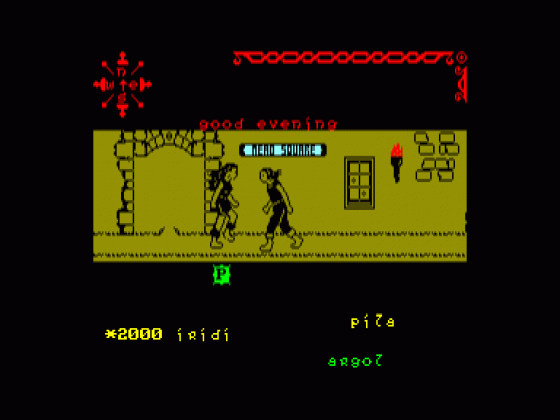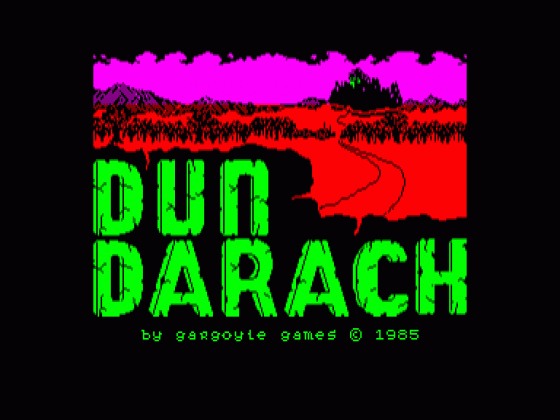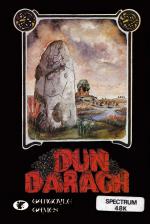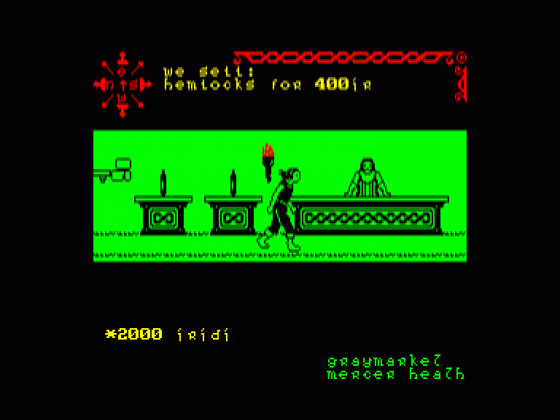
Crash
 1st July 1985
1st July 1985
Categories: Review: Software
Author:
Publisher: Gargoyle Games
Machine: Spectrum 48K
Published in Crash #18
Dun Darach
The hero is back! We were first introduced to the 7-characters high Cuchulainn the great in Tir Nag Nog, now he returns in this epic game, Dun Darach. This time there is a very subtle difference between Cuchulainn as seen in Tir Na Nog and Cuchulainn in Dun Darach, he is alive! No he hasn't been reincarnated for reuniting the Seal Of Calum, this adventure is set in the early years before Tir Na Nog.
Following a bloody and pointless battle against the Conachta, In which the Amhair, a prince of the Conachta, had been killed, Cuchulainn the Great was returning home with his faithful charioteer, Loeg.
Towards the end of the second day they stopped at a wayside inn, leaving the chariot beside a strange horse drawn carriage. While they waited for food they were approached by Skar, a strikingly beautiful girl. She told them that she was the owner of the strange chariot and that she required assistance to mend a broken axle. Loeg, unsurprisingly, leapt to assist her and left the inn with Skar.

After a while Cuchulainn ventured outside, but to his astonishment there was no sign of either Loeg or Skar. Instead one of the proud horses that pulled the chariot lay slain. Of the Oak carriage, there was only a cloud of disappearing dust and on the wind a hint of ghostly girlish laughter.
Skar was, it seemed, a Sorceress and ally of the Connachtmen, and she had seized Loeg in retribution for the Princeling's death, and had taken him, body and soul, to the secret city of Dun Darach....
So the scene is set and you as Cuchulainn must seek out the whereabouts and rescue Loeg from Skar. On the way to achieving this you must complete several sub quests such as finding a particular gift for someone in return for another object which will prove useful in your quest.

The city of Dun Darach is split into several parts which all have their own characteristics, the pleasure area has gambling houses and the finance area has banks. Within each area the streets all have their own names and all the doors are numbered, which makes mapping and navigation easier. Doors can be entered by standing in front of them and pressing enter, the scene then cuts to the interior of the room. The reverse is true should you wish to exit a room.
The main difference between Tir Na Nog and Dun Darach is interaction. In Tir Na Nog you rarely needed to interact with the other characters, but interaction plays an important part in Dun Darach. There are two basic forms of interaction - trading with shopkeepers and brokers, and trying to prize bits of information out of the main characters.
Trading with shopkeepers is very simple. On entering a shop a message is displayed at the top of the screen which tells you what goods the shopkeeper sells or buys and at what price. If you are buying something then you pick up the object and offer the shopkeeper money. If you have enough money then the shopkeeper says 'thank you' and the goods are yours. If, on the other hand, you don't have enough money you can always try stealing the goods. This is done by picking up the object and walking out of the shop with it. Some of the more expensive goods, like the thieves' licence cannot be stolen and if you try to steal them the door locks until you have either paid for the goods or put them back.

Sometimes you are in the position where you have some goods which another shopkeeper wishes to purchase. Just offer the shopkeeper the goods and he will give you money in return. Of course instead of buying and selling at a profit you could always steal some goods and sell them to another shopkeeper for huge profit. Should Ryde, a sort of local bobby, catch you in possession of some stolen goods then all your money, unless you have banked some of it, and all the possessions you are carrying will be taken.
Communicating with the characters that roam the streets is slightly harder. First of all you must find out what each character wants, which sends you on a sub-quest to find the object. Once found you you can offer the object to a character who may give you something in return. While walking the streets you must beware of the local pick-pockets who will gladly take your money and many of your goods should you happen to bump into them, unless you are a member of the Thieves Guild of course. All together there are ten main characters to interact with and you must get to know each one's personal likes and dislikes.
As well as the shops and the brokers there are several other different types of room. There are the bankers, deposit rooms, portals, gambling houses, magic rooms and galleries. The is a good honest way of making money at a steady rate. The minimum deposit is 1000 iridi (the local currency) and the interest rate is 1% per day. The days are calculated by the torches that appear on the walls, night when they are on and day when off. This only applies when outside a building, inside the torches are permanently on. While your money is in the bank it is safe from all the other characters.
Deposit rooms are, as the name suggests, rooms where you can deposit goods, for a fee of course. You just enter the room and drop the object on the table and a fee is deducted as you leave.
In Tir Na Nog there were a set of rooms which would transport you to other parts of the land. The same principle has been implemented in Dun Darach except on most of the portals you have to pay a fee. This is a quick and easy way to travel about the city should you be in hurry.
Gambling houses are a quick and easy way of making money or losing it! On one of the walls is a set of two dice. These spin around and after a while stop to show two numbers. The game is played by placing a bet on either the A or B table. Each table has its own numbers and odds and if the sum of the dice adds up to a number on one of the tables you have either won or lost. This in itself provides an enjoyable alternative to all the walking about and trading.
Magic rooms tend to give you messages which are clues if you buy spells from there. Also scattered throughout the city are rooms which are called Hail- followed by another name. If you take a shield with the same name and place it on the table in the room then a picture in the room changes to another symbol which gives you a clue.
The galleries contain pictures of objects or just pictures of things connected with objects. If you have got one of the objects connected with a picture then drop it on the nearby table and a tick will appear on the picture. Here the Gargoyle sense of humour is best displayed, as it was in Tir Na Nog - remember the N and egg (the connection being N's lay eggs), this makes working out some of the clues very hard, but if all else fails you could always try trial and error. On completing a gallery you are given a new object or a clue about how to do something else.
The screen is a bit smaller than that used in Tir Na Nog but none of the detail has been lost, the upper and lower parts being used to display messages and objects carried etc. The same 'camera view' technique that was used in Tir Na Nog has been used in Dun Darach which means it is possible to get views of both sides of a street, this can also help you avoid other characters such as the pick-pockets. Cuchulainn is positioned in the centre of the screen and the streets scroll smoothly as he walks. The other main characters as represented by one basic male and female character. When a character besides Cuchulainn is on screen (except shopkeepers and brokers) then their name is displayed at the bottom of the screen and a coloured square follows them with their initial in it. This means characters can easily be identified especially when there are several on screen.
As you can see Dun Darach relies heavily on interaction with other characters and finance. Don't let this fool you into thinking that all the types of problems experienced in Tir Na Nog have vanished, you still have to work out various puzzles. Dun Darach should prove tricky to solve for a couple of months because the game is so complex. It comes supplied in a lavish box complete with a detailed booklet and a rough map of the city.
Comments
Control keys: Left/Right alternate keys from Z to Symbol shift, change camera view A to L, enter a door ENTER, pick up/drop alternate keys on the third row Q to P, select object 2 3 7 8 9, offer object the four corner keys
Joystick: only programmable
Keyboard play: quite a few keys but easy to use and responsive
Use of colour: excellent, no attribute problems
Graphics: unbelievable animation and stunning backgrounds
Sound: limited spot effects
Skill levels: just the one, but you can't die, you can only be robbed and taken in by confidence tricks
Screens: scrolling streets plus over 100 rooms and doors
Comment 1
'Oh no! Please not again! I've only just completed Tir Na Nog and I thought I deserved a well earned rest. But alas I have been forced to roam the streets of Dun Darach and try to work out all the nasty problems that Greg Follis has thought up for us, which will no doubt mean more sleepless nights. I don't think I can stand it any longer! The graphics are as good as those in Tir Na Nog, if not better, and the animation leaves nothing to be desired. Fortunately there are no nasty horrible Sidhe to contend with just characters the same size as Cuchulainn which, fortunately, don't kill you. I didn't think it was really possible to improve on Tir Na Nog but somehow Gargoyle have pulled it off. Colour is used well with no attribute problems, even when characters walk across each other. Overall a superb game that should keep you glued to your TV sets throughout the summer (and autumn, winter and spring). Definitely a strong contender for game of the year!'
Comment 2
'Cuchulainn the Great is off on his travels again in this epic game from Gargoyle Games. I was amazed by the sheer quality of the graphics which are amongst the best I have ever seen! The animation is fantastic and now that there are more characters in the game it means it is one of the best looking games around. The game is a bit hard to get into but once you start getting somewhere you will love it. I found the game totally addictive and utterly playable. Overall a truly fantastic game that deserves to be a huge hit in fact I'm pretty sure it will be a hit!
Comment 3
'The long awaited sequel to Tir Na Nog has at last arrived it was certainly worth the wait. It must have been hard to surpass the graphics in Tir Na Nog, but Gargoyle have done it, just look at the other characters, the rats and the torches and you will see what I mean. Sound isn't up to much, just the odd spot effect but you tend to get so engrossed in the game itself that you don't care what the sound is like. As with Tir Na Nog there are no attribute problems which is surprising because there are more than one colour is being used on screen at a time. The adventure element is a bit tough to get into but you can always go gambling or just stealing goods and selling them at a huge profit, a bit risky but worth it. The save game facility is one of the best I have ever used and it is very quick and reliable. How Gargoyle packed so much into 48K I will never know, there is just so much going on that it is unbelievable. If you liked Tir Na Nog (or even if you didn't) you will love Dun Darach. Excellent value for money and a must for any respectable Spectrum owner. Terrific - just buy it!
Other Reviews Of Dun Darach For The Spectrum 48K
Dun Darach (Gargoyle Games)
A review
Dun Darach (Gargoyle Games)
A review by Richard Price (Sinclair User)
Dun Darach (Gargoyle Games)
A review
Dun Darach (Gargoyle Games)
A review













